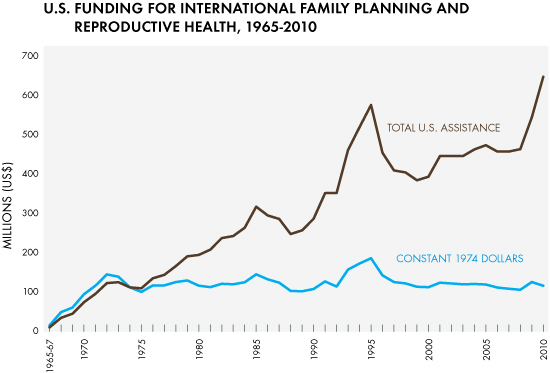The Other 1%
Oct 20th, 2011 | By admin | Category: Economics and GDP, Family PlanningBy Suzanne York, HowMany.org, October 20, 2011
One percent is in the news a lot lately, with the Occupy Wall Street protests targeting bankers and the wealthiest Americans who comprise 1% of our population.
But there is another 1% that we should keep in mind. Though it may be small, this other 1% is doing a lot of good. It’s the roughly 1% of the U.S. federal budget that goes to foreign aid. According to a recent survey, most Americans believe the figure should be 10% because they think foreign aid makes up 25% of the budget.
With global population soon to hit 7 billion, how can 1% of foreign aid be put to good use in terms of family planning, reproductive health, and improving lives (which will also contribute to stronger and more stable nations)? Certainly in the current economic climate of fiscal restraint and congressional partisanship, funding for international programs won’t be increasing. We can lament the low funding, but in the end, it’s what we have to work with; so yes, we have to do better with less, and be smarter and strategic with funding.
International family planning and reproductive health programs amounted to $615 million in 2011 (with $40 million of that earmarked for the United Nations Population Fund, an organization disliked by many conservatives). According to the Guttmacher Institute, this level of funding makes it possible for:
- 37.4 million women and couples to receive contraceptive services and supplies;
- 11.7 million unintended pregnancies and 5.1 million unplanned births to be averted;
- 5.1 million induced abortions to be averted (3.7 million of them unsafe);
- 32,000 maternal deaths to be averted; and
- 140,000 fewer children to lose their mothers.
That’s a lot of benefit for a price tag which is less than what quite a few hedge fund managers make in a year!
Graph: Population Action International, http://populationaction.org/Articles/US_Assistance_Trends.php
Money for family planning programs are mainly disbursed through the United States Agency for International Development and the United Nations Population Fund. They in turn give grants to organizations and entrepreneurs building successful endeavors in reproductive health and family planning, showing that we can do a lot with less.
U.S. Agency for International Development: Success Stories
The U.S. Agency for International Development (USAID) implements and supports family planning initiatives, many of which have a positive impact on global reproductive health.
USAID supported Rwanda’s efforts to prioritize national family planning services. The Rwandan government implemented a new family planning strategy in 2007, resulting in a 17% increase in the rate of contraceptive use between 2005 and 2008. In 2008, USAID trained nearly 5,900 providers of family planning services who provided those services to thousands of Rwandans.
In Bangladesh, USAID used a community based distribution program to increase contraceptive use among poor families. The program included training female outreach workers to go door-to-door to provide family planning information and services. Today a majority of women in Bangladesh are aware of modern family planning methods, and fertility decreased from an average of more than six children per woman in 1975 to slightly more than three.
Other success stories in USAID’s family planning programs include countries that have received significant U.S. support for family planning in the past – such as Brazil, Indonesia, Mexico, South Korea, and Thailand. These have now stabilized their populations and have moved from being recipients to donors of family planning assistance.
United Nations Population Fund: Successful Initiatives
The mission of the United Nations Population Fund (UNFPA) is to“reduce poverty and to ensure that every pregnancy is wanted, every birth is safe, every young person is free of HIV/AIDS, and every girl and woman is treated with dignity and respect.”
The UNFPA is addressing the sexual and reproductive health needs of women by improving education and access to female condoms via its Female Condom Initiative. Initial success in Malawi and Zimbabwe has spread to other countries such as Zambia and Myanmar. Global distribution of female condoms more than tripled from 2005 to 2009, and targeted distribution efforts strove to reach remote and rural populations with marginalized groups. The program has since evolved into the Global Condom Initiative, with a focus on comprehensive education on both female and male condoms.
With support from the UNFPA, the Dasholi Gram Samaj Mandal women-led environmental movement in India has worked to educate communities that natural resource conservation was a critical issue for women and men. Their initiative resulted in reforestation and reduced damage from floods and landslides. It also made the daily tasks of collecting water and wood easier for women. Furthermore, it effectively demonstrated women’s leadership abilities and improved the sustainability of their environment.
The Future of 1%
House Republicans have proposed significant funding reductions to foreign aid, including a 25% cut to family planning and reproductive health programs, plus more restrictions, including a ban on UNFPA funding. This, despite the fact that investments in family planning and reproductive health services have resulted in lower maternal and infant mortality, lower fertility rates, an increase in girls and boys staying in school, delayed child marriages, and improved economic opportunities.
As we consider the protests against the wealthiest 1%, we should also reflect on the power of 1% in foreign aid, especially money spent on family planning, and think what could be accomplished with just a little more. Perhaps Bill Gates should join in, as he has stated that “In the long run, not spending on health is a bad deal for the environment because improvements in health, including voluntary family planning, lead people to have smaller families, which in turn reduces the strain on the environment.” He’s part of the 1% that understands the importance of the other 1%.


